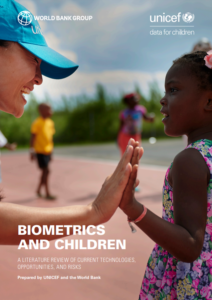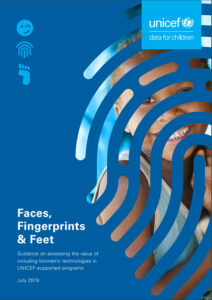Biometrics
UNICEF guidance on the use of biometrics in children-focused services

Biometric technology presents a broad range of potential benefits to enhance programmes for children through improved data linkage, supporting more holistic service provision for children on the move, preventing fraud in cash payment systems and making interactions with service providers simpler. However biometrics also pose specific risks to children – above and beyond the data protection and privacy concerns that apply to all biometric applications. This technology has been largely designed to work with adults and may not perform as well when used with children. Errors in biometric recognition can result in potential exclusion from important services and create additional barriers for marginalised and vulnerable groups.
At UNICEF, we are looking closely at how we can balance the benefits and risks from biometric technologies to support the best possible development outcomes for children while ensuring their rights are protected. As a first step in this process, we have been working on two key pieces of guidance that we are sharing here.
1. Faces, Fingerprints and Feet: Guidance on assessing the value of including biometric technologies in UNICEF-supported programmes
This document outlines the 10 key questions and criteria that UNICEF programmes are encouraged to ask when evaluating whether to invest or support the use of biometric technologies as part of our own programming. These questions provide a critical lens to help weigh up the benefits and risks and ensure that appropriate management strategies are in place so that biometrics can be used safely. It is provided here as a public good for other organisations, governments or groups that are also working in this space and want to ensure that they have gone through an appropriate review process of any planned biometric activities.
2. Biometrics and Children: A literature review of current technologies – prepared by UNICEF and the World Bank

This document examines the publicly available literature on the performance of biometric technologies for children (0-18 years). The level of evidence available and performance metrics are provided for key biometric traits commonly proposed for use with children including facial recognition, fingerprints, iris scans, foot and palm prints. Key findings from the study highlight that while biometric technologies have some application in children above 5 years of age, solutions at younger ages are largely experimental and require more research. The work also highlights the critical lack of verifiable performance data on most of the technologies currently in use with children (particularly for longitudinal use over extended periods), and the need for more transparency and critical assessment of the impact of population-scale applications.
